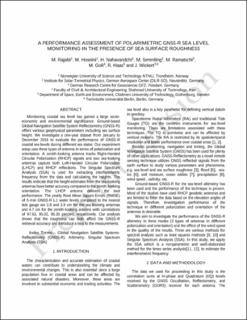A Performance Assessment of Polarimetric GNSS-R Sea Level Monitoring in the Presence of Sea Surface Roughness
Rajabi, Mahmoud; Hoseini, Mostafa; Nahavandchi, Hossein; Semmling, Maximilian; Ramaschi, Markus; Goli, Mehdi; Hass, R ̈udiger; Wickert, Jens
Peer reviewed, Journal article
Accepted version

Åpne
Permanent lenke
https://hdl.handle.net/11250/2989291Utgivelsesdato
2021Metadata
Vis full innførselSamlinger
Originalversjon
IEEE International Geoscience and Remote Sensing Symposium proceedings. 2021, 8328-8331. 10.1109/IGARSS47720.2021.9554562Sammendrag
Monitoring coastal sea level has gained a large socioeconomic and environmental significance. Ground-based Global Navigation Satellite System Reflectometry (GNSS-R) offers various geophysical parameters including sea surface height. We investigate a one-year dataset from January to December 2016 to evaluate the performance of GNSS-R coastal sea levels during different sea states. Our experiment setup uses three types of antenna in terms of polarization and orientation. A zenith-looking antenna tracks Right-Handed Circular Polarization (RHCP) direct signals and two sea-looking antennas capture both Left-Handed Circular Polarization (LHCP) and RHCP reflections. The Singular Spectrum Analysis (SSA) is used for extracting interferometric frequency from the data and calculating the heights. The results indicate that the height estimates from the sea-looking antennas have better accuracy compared to the zenith-looking orientation. The LHCP antenna delivers the best performance. The yearly Root Mean Square Errors (RMSE) of 5-min GNSS-R L1 water levels compared to the nearest tide gauge are 2.8 and 3.9 cm for the sea-looking antennas and 4.7 cm for the zenith-looking antenna with correlations of 97.63, 95.02, 95.35 percent, respectively. Our analysis shows that the roughness can introduce a bias to the measurements.